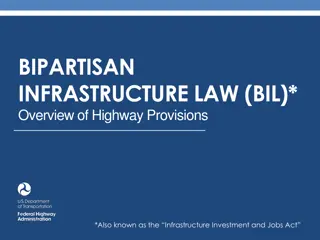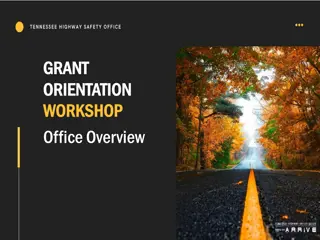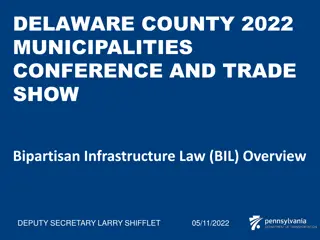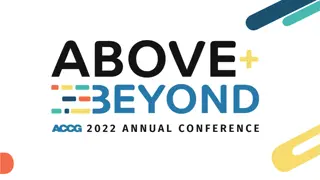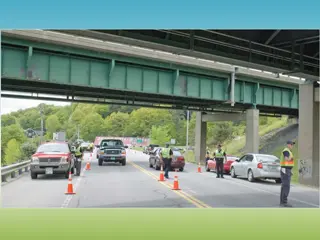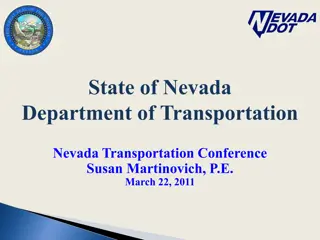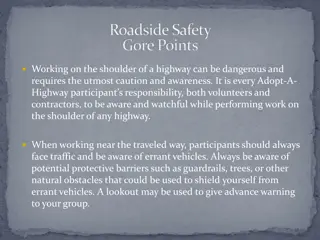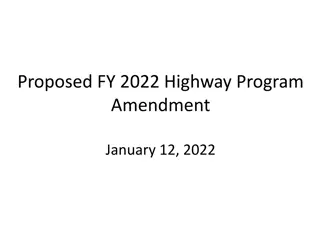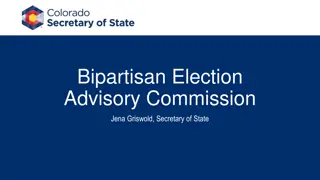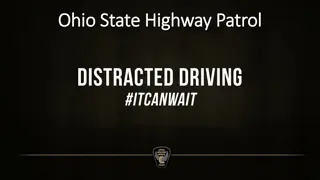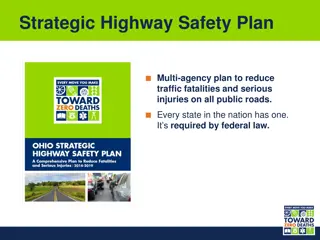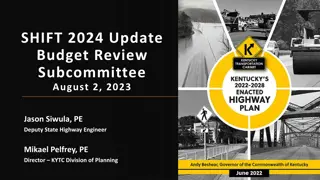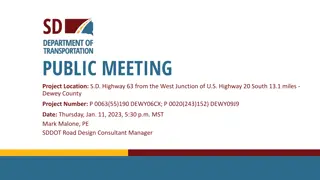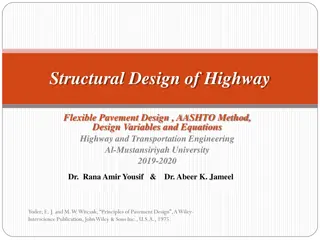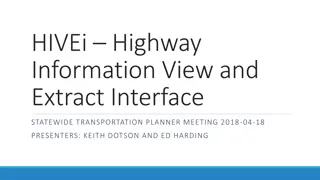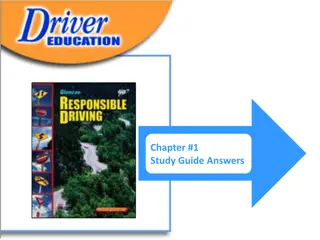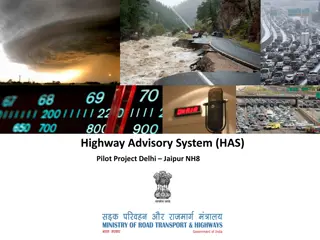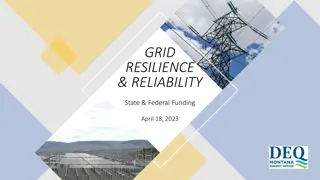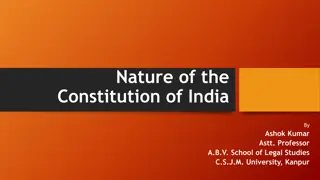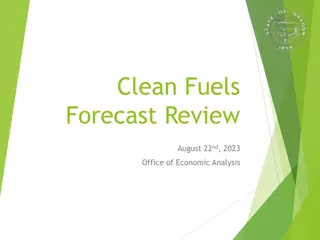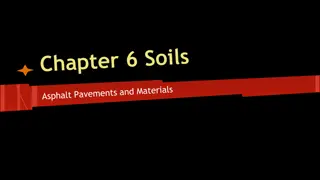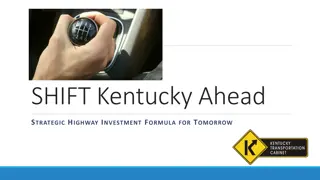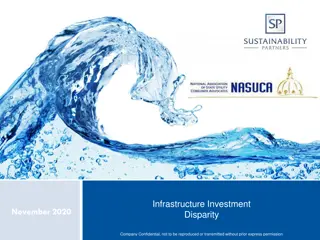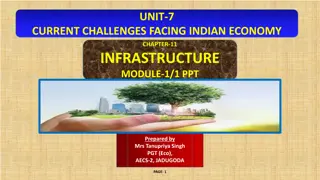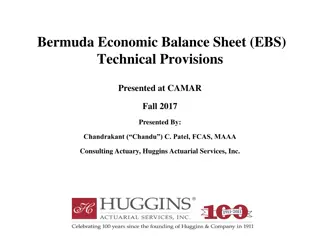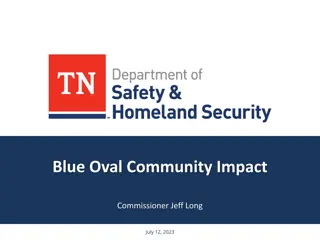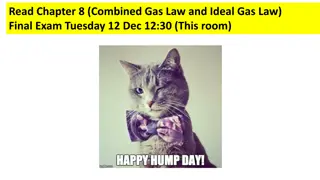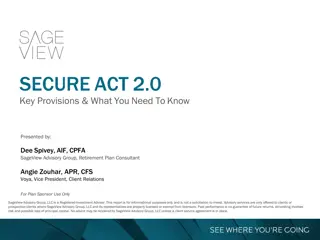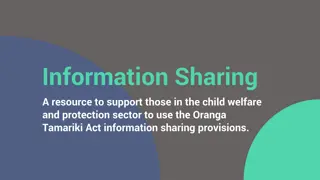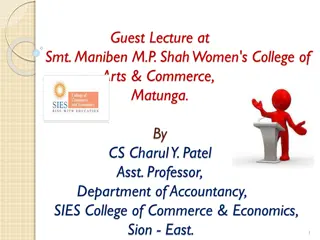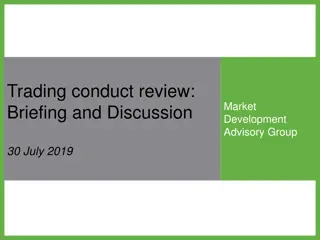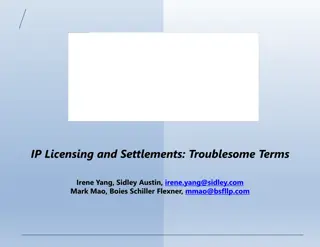Bipartisan Infrastructure Law - Overview of Highway Provisions
This presentation provides an overview of the highway provisions in the Bipartisan Infrastructure Law (BIL), also known as the Infrastructure Investment and Jobs Act. It focuses on significant programs and provisions related to highways, offering insight into budget authority, contract authority, obligations, and the Highway Trust Fund. The BIL goes beyond transportation, including a substantial budget allocation over FY 2022-2026.
- Bipartisan Infrastructure Law
- Highway Provisions
- Infrastructure Investment
- Transportation Funding
- Government Legislation
Download Presentation

Please find below an Image/Link to download the presentation.
The content on the website is provided AS IS for your information and personal use only. It may not be sold, licensed, or shared on other websites without obtaining consent from the author. Download presentation by click this link. If you encounter any issues during the download, it is possible that the publisher has removed the file from their server.
E N D
Presentation Transcript
BIPARTISAN INFRASTRUCTURE LAW (BIL)* Overview of Highway Provisions [Insert name here] [Insert office] [Insert date] *Also known as the Infrastructure Investment and Jobs Act
SETTING THE STAGE Introductory Notes Key Terms
3 Introductory Notes This presentation: o focuses on highway provisions in the BIL o provides an overview of significant programs and provisions, but it is not all inclusive o does not include programs that BIL authorizes subject to future appropriation o includes information on several relevant programs that the Office of the Secretary will administer Section ( ) references in the presentation refer to BIL sections References to Division J refer to the appropriations portion of BIL (Title VII relates to the U.S. Department of Transportation) For more information, please visit the Federal Highway Administration s BIL website: fhwa.dot.gov/bipartisan-infrastructure-law Disclaimer: Except for any statutes or regulations cited, the contents of this presentation do not have the force and effect of law and are not meant to bind the public in any way. This presentation is intended only to provide information regarding existing requirements under the law or agency policies.
4 Key Terms Budget Authority: authorization by Congress that allows Federal agencies to incur obligations that will result in the outlay of funds Contract Authority (CA): form of Budget Authority that permits obligations to be made in advance of appropriations Appropriated Budget Authority (ABA): Budget authority to incur obligations and to make payments from the Treasury for specified purposes Advance Appropriations: appropriated funds that become available for obligation one or more fiscal years after the year for which the appropriation was enacted Apportionment: the distribution of funds to States as prescribed by statutory formula Allocation: an administrative distribution of funds for programs that are not distributed to States by statutory formula Obligation: the Federal government s legal commitment to pay or reimburse entities for the Federal share of a project s eligible costs Highway Trust Fund (HTF): account established by law to hold Federal highway- user taxes that are dedicated for highway and transit related purposes
BIL HIGHLIGHTS Milestones Toward Enactment of BIL BIL Goes Beyond Transportation Includes $567.1 B (All DOT Modes) Over FY 22-26 High Points of BIL Highway Provisions
6 Milestones Toward Enactment of BIL Date Milestone July 2021 August 10, 2021 Senators released bipartisan infrastructure framework Senate passed Bipartisan Infrastructure Deal (BIL) November 5, 2021 House passed BIL November 15, 2021 President Biden signed BIL into law (Public Law No: 117-58)
7 BIL Goes Beyond Transportation Once-in-a-generation investment in infrastructure Grows the economy, enhances U.S. competitiveness, creates good jobs, and makes the U.S. economy more sustainable, resilient, and equitable Around $550 B in new Federal infrastructure investment, including o Largest federal investment in public transit ever o Largest federal investment in passenger rail since the creation of Amtrak o Largest dedicated bridge investment since the construction of the Interstate System o Largest investment in clean drinking water & wastewater infrastructure in U.S. history o Largest investment in clean energy transmission & electric vehicle infrastructure in history o Ensuring every American has access to reliable high-speed internet On average, around 2 million jobs per year
8 Includes $567.1 B (All DOT Modes) Over FY 22-26 Program Contract Authority (CA) ($ B, FY 22-26) Advance appropriations ($ B, FY 22-26) Federal Aviation Administration --- 25.0 Federal Highway Administration 303.5 47.3 Federal Motor Carrier Safety Administration 4.5 0.7 Federal Railroad Administration / Amtrak --- 66.0 Federal Transit Administration 69.9 21.3 Maritime Administration --- 2.3 National Highway Traffic Safety Administration 5.1 1.6 Office of the Secretary --- 19.0 Pipeline & Hazardous Materials Safety Admin. --- 1.0 Total 383.0 184.1 Note: Table does not include amounts that BIL authorizes but are subject to [future] appropriation
9 High Points of BIL Highway Provisions Funds highway programs for five years (FY 22-26) $350.8 B (FY 22-26) for highway programs o $303.5 B in Contract Authority (CA) from the Highway Trust Fund (HTF) o +$47.3 B in advance appropriations from the General Fund (GF) More than a dozen new highway programs, including o Formula: resilience, carbon reduction, bridges and electric vehicle (EV) charging infrastructure o Discretionary: bridges, EV charging infrastructure, rural projects, resilience, wildlife crossings, and reconnecting communities Focus on safety, bridges, climate change, resilience, and project delivery More opportunities for local governments and other non-traditional entities to access new funding $90 B transfer (GF->HTF) to keep the HTF Highway Account solvent for years
$350.8 B (FY 22-26) FOR HIGHWAY PROGRAMS $303.5 B in Contract Authority from the HTF +$47.3 B from the General Fund (GF) for Highway Infrastructure Programs (HIP) Nine Categories of HIP Funding Under BIL (from the GF) Funding Available to a Range of Recipients
11 $303.5 B in Contract Authority from the HTF Five years of funding (FY 22-26) BIL highway CA, apportioned vs. allocated +29% highway CA (avg. annual, FY 22-26) vs. current law (FY 21) Mostly (90%) apportioned to States 90% apportioned (formula) All FAST Act highway programs will continue 10% allocated plus new CA programs (apportioned and allocated)
12 +$47.3 B from the General Fund (GF) for Highway Infrastructure Programs (HIP) Majority (72%) distributed by formula BIL HIP advance appropriations, formula vs. discretionary All provided from the General Fund 28% discretionary 9 categories of advance appropriations; 6 supplemental to CA 72% formula
13 Nine Categories of HIP Funding Under BIL (from the GF) Total, FY 22-26 $27.5 B Program Bridge Formula Program $9.2 B* Bridge Investment Program (discretionary) $5.0 B National Electric Vehicle Formula Program $3.2 B* INFRA Program $1.3 B Appalachian Development Highway System (ADHS) $0.5 B* Reconnecting Communities Pilot Program $0.3 B* Ferry Boat Program $0.2 B* Reduction of Truck Emissions at Port Facilities $0.1 B* University Transportation Centers (UTCs) * Supplements CA separately provided by BIL for this program
14 Funding Available to a Range of Recipients Program Examples State PR* MPO Local Tribe PA** Territory FLMA** Apportioned programs (formula) * Bridge Program (formula) National Electric Vehicle Formula Program Safe Streets and Roads for All program PROTECT Grants (discretionary) *** *** Charging and Fueling Infrastructure Program Congestion Relief Program Bridge Investment Program (discretionary) *** Reconnecting Communities Pilot Program Rural Surface Transportation Grants INFRA *** National Infrastructure Project Assistance Local and Regional Project Assistance Natl. Significant Fed. Lands & Tribal Projects *** *** *** *** *** Tribal Transportation Program Safety Fund Note: This table does not include all BIL programs or eligible entities, and there are additional nuances not represented in this table. Additional programmatic information is provided in later slides. FHWA will administer most, but not all, programs listed. * PR = Puerto Rico, has funding allocated from 23 USC 165(b)(2)(C). Of that funding, least 50% is for purposes eligible under NHPP and 25% under HSIP, and the remainder is for other activities eligible under chapter 1 of title 23. ** PA = a special purpose district or public authority with a transportation function; FLMA = Federal Land Management Agency *** May be eligible if partnered with an eligible entity, or under other specific conditions. For example, territories can apply for PROTECT at-risk coastal infrastructure grants [23 USC 176(d)(4)(C)]. See program information sources for more details.
APPORTIONED HIGHWAY PROGRAMS 8 Apportioned CA Programs (Including 2 New) Changes to Existing CA Programs (NHPP, STBG, HSIP, CMAQ, and NHFP)
16 8 Apportioned CA Programs (Including 2 New) 160 148.0 140 Contract Authority 120 $ B, FY 22-26 100 7.2 (Transportation Alternatives) 80 60 64.8 40 1.2 (Railway-Highway Crossings Program) 20 6.4 7.3 7.2 2.3 15.6 13.2 0 NHPP STBG HSIP CMAQ PL NHFP Carbon reduction [NEW] PROTECT (formula) [NEW] Federal-aid apportioned programs under BIL
11105 17 Changes to National Highway Performance Program (NHPP) Topic Program purpose Changes Adds as an additional program purpose: providing support for activities to increase the resiliency of the NHS to mitigate the cost of damages from sea level rise, extreme weather events, flooding, wildfires, or other natural disasters Adds new eligible projects: undergrounding public utility infrastructure carried out in conjunction with an otherwise eligible project resiliency improvements (including protective features) on the NHS activities to protect NHS segments from cybersecurity threats. protective features (related to mitigating risk of recurring damage or the cost of future repairs from extreme weather events, flooding, or other natural disasters) on Federal-aid highways/bridges off the NHS ( 15% of NHPP funds) Requires consideration of extreme weather and resilience in lifecycle cost and risk management analyses Eligible projects Asset management plans
11109 18 Changes to Surface Transportation Block Grant Program (STBG) Topics Eligible projects Changes Adds several new types of eligible projects, including: EV charging infrastructure protective features to enhance resilience wildlife crossing projects Off-system bridges Increases off-system bridge set-aside Adds eligibility to include replacing a low water crossing with a bridge Population categories for sub-allocation split into smaller ranges: o < 5,000 o [NEW] 5,000 49,999 o [NEW] 50,000 200,000 o >200,000 Requires States to consult with RTPOs and MPOs for urbanized areas with 50,000-200,000 pop. before using certain suballocated funding Permits States to use up to 15% of funds for eligible projects or maintenance on non-Federal aid highways in rural areas, and up to 5% for certain barge landing, dock and waterfront infrastructure projects Sub- allocation Rural areas
11109 19 Changes to Transportation Alternatives (TA) Set- aside from STBG Topic Funding Changes Increases funding, setting it at 10% of total STBG funds each FY Increases from 50% to 59% the portion of TA funds that must be suballocated to areas of the State based on population Continues to permit States to transfer up to 50% of TA funds to any other apportioned program but establishes new conditions Allows States to use up to 5% of available funds (after suballocation) to fund staff to administer the TA program and assist applicants Reaffirms eligibility for safe routes to school projects and activities Adds activities relating to vulnerable road user safety assessments Eligible projects Eligible entities Federal share Adds as eligible entities MPOs representing a pop. 200,000, any nonprofit entities, and States at the request of another eligible entity Subject to certain requirements: provides for a Federal share up to 100% allows HSIP funds to be used toward the non-Federal share allows non-Federal share requirements to be met on an aggregate basis instead of by project
11111 20 Changes to Highway Safety Improvement Program (HSIP) Topic Eligible projects Changes Adds eligibility ( 10% of HSIP funds) for specified safety projects (including non-infrastructure safety projects related to education, research, enforcement, emergency services, and safe routes to school) Modifies the HSIP definition of highway safety improvement project by adding or clarifying some project types. Some examples include: o railway-highway crossing grade separation projects; o traffic control devices for pedestrians and bicyclists; and o roadway improvements that separate motor vehicles from bicycles or pedestrians Requires States to complete vulnerable road user (VRU) safety assessments, taking into consideration a Safe System approach Adds new special rule for States with total annual VRU fatalities comprising 15% of total annual crash fatalities in State Vulnerable road users
11108 21 Changes to Railway-Highway Crossings Program (RHCP) Topic Changes Eligible projects Clarifies funds are eligible for projects to reduce pedestrian fatalities and injuries from trespassing at grade crossings (ped safety improvements at crossings are already an eligible activity) Eliminates the 50% set-aside for protective devices Increases the maximum incentive payment that a State may pay a local government for closing a public at-grade railway-highway crossing from $7,500 to $100,000, subject to certain conditions Increases from 2% to 8% the amount a State may use for data compilation and analysis in support of its annual RHCP report Increases the Federal share for projects financed with funds set aside for this program from 90% to 100% Requires FRA to summarize highway-rail grade crossing action plans and evaluate each State railway-highway crossing program and submit report to Congress on the results ( 22401) Requires FRA, in consultation with FHWA, to update the report based on State annual reports required under the program and submit it to Congress ( 22403) Uses of funding Federal share Reports
11115 22 Changes to Congestion Mitigation and Air Quality Improvement Program (CMAQ) Topic Eligible projects Changes Adds eligibilities for o shared micromobility (e.g., bikeshare, shared e-scooters) o purchase of diesel replacements o purchase of medium/heavy-duty zero emission vehicles and related charging equipment o modernization/rehab of a lock and dam or a marine highway corridor, connector, or crossing, if certain criteria are met ( 10% of CMAQ funds) CMAQ funds may be used for rail/transit operating assistance (w/o time limitation) in association with certain CMAQ projects located in certain areas Requires, to the maximum extent practicable, prioritizing disadvantaged communities or low-income populations when obligating funds to reduce PM2.5 emissions Rail/transit operating assistance Equity
11114 23 Changes to National Highway Freight Program (NHFP) Topic Freight intermodal/ freight rail projects Locks, dams, marine highways Changes State may use 30% (vs. 10% under current law) of NHFP funding on freight intermodal or freight rail projects, subject to certain restrictions Adds eligibility for modernization/rehab of a lock and dam or a marine highway corridor, connector, or crossing (including an inland waterway corridor, connector, or crossing) that are: o functionally connected to the National Highway Freight Network; and o likely to reduce on-road mobile source emissions Allows the designation of more miles as critical rural freight corridors and critical urban freight corridors Critical freight corridors
SAFETY Highway Safety Improvement Program (highlighted earlier) Railway-Highway Crossings Program (highlighted earlier) Safe Streets and Roads for All Wildlife Crossings Pilot Program Other Safety-related Provisions
24112 25 [NEW] Safe Streets and Roads for All (discretionary) Purpose Support local initiatives to prevent transportation-related death and serious injury on roads and streets (commonly referred to as Vision Zero or Toward Zero Deaths initiatives). $5.0B (FY 22-26) in advance appropriations from the GF Funding Eligible entities MPO Political subdivision of a State (e.g., local governments) Tribal government Developing comprehensive safety action plans (planning grant) Conducting planning, design, and development activities for infrastructure projects and strategies identified in a comprehensive safety action plan Carrying out projects and strategies identified in a comprehensive safety action plan Sets aside not less than 40% of total funding each FY for planning grants. Requires considering, among other factors, the likelihood of a project significantly reducing or eliminating fatalities and serious injuries involving various road users, including pedestrians, bicyclists, public transportation users, motorists, and commercial operators. Eligible projects Other key provisions
11123 26 [NEW] Wildlife Crossings Pilot Program (discretionary) Purpose Support projects that seek to reduce the number of wildlife-vehicle collisions, and in carrying out that purpose, improve habitat connectivity $350 M (FY 22-26) in Contract Authority from the HTF State highway agency (or equivalent), including Puerto Rico Highway and Transportation Authority MPO Local government Regional transportation authority Special purpose district or public authority with a transportation function Indian Tribe Federal land management agency Eligible projects Projects to reduce wildlife-vehicle collisions Funding Eligible entities Other key provisions Sets aside not less than 60% of grant funds for projects in rural areas Provision related to pilot program requires: o study of methods to reduce wildlife-vehicle collisions; o workforce development and technical training courses; o standardized methodology for collecting and reporting spatially accurate wildlife collision and carcass data for the NHS; and o guidance on evaluating highways for potential mitigation measures to reduce wildlife-vehicle collisions and increase habitat connectivity.
27 Other Safety-related Provisions Program/topic Provisions in the new law Increasing Safe and Accessible Transportation Options ( 11206) Defines Complete Streets standards and policies Requires each State and MPO to carry out transportation planning activities related to complete streets or multimodal travel using o State: at least 2.5% of its State Planning and Research (SPR) funds o MPO: at least 2.5% of its Metropolitan Planning (PL) funds Adds to MUTCD purposes inclusion and mobility for all users Manual on Uniform Traffic Control Devices (MUTCD) ( 11129, 11135) Requires MUTCD update within 18 months, every 4 years thereafter Requires first update to provide for protection of vulnerable road users to the greatest extent possible, among other specified elements
WORKFORCE Davis-Bacon and Buy America Provisions Other Workforce Provisions
29 Davis-Bacon and Buy America Provisions Program/topic Davis-Bacon (various sections) Buy America requirements for title 23 projects ( 11513) Buy America requirements for all infrastructure projects receiving Federal assistance ( 70911-70917) Provisions in the new law Davis-Bacon wage requirements apply for most major highway programs Buy America waivers for title 23 projects require public notice of proposed waivers, public comment, annual report to Congress New Buy America requirements apply to all infrastructure projects receiving Federal financial assistance o Manufacturing processes for iron, steel, construction materials and manufactured products must occur in U.S. o Cost of components of manufactured products mined, produced, or manufactured in U.S. must be >55% of the cost of all components o Waivers only if applying requirement is not in the public interest, materials are not available, or meeting requirement would increase overall project cost by >25% (to be reviewed every 5 years) o Requires Federal agencies to identify deficient programs not meeting the new Federal government-wide Buy America requirement
30 Other Workforce Provisions Program/topic Provisions in the new law Local hiring preference for construction jobs ( 25019) Permits a recipient or subrecipient of funding under title 23 or 49, United States Code to implement a local or other geographical or economic hiring preference relating to the use of labor for construction projects consistent with State/local laws and policies. Requires DOT to submit a Workforce Diversity Report to Congress, followed by a model plan for States, local governments, and private sector entities to use The report and model plan must address methods to enhance pre-apprenticeship programs, improve transportation workforce diversity, and encourage (sub)recipients to establish outreach and support programs Expands eligibility to include a variety of training and employment activities Surface transportation workforce development, training, and education ( 13007) Transportation education and training development and deployment program ( 13007) Expands eligibility to State DOTs and partnerships with Federal departments and agencies Expands program to include implementing new curricula and education programs to provide hands-on career opportunities to meet current and future needs
CLIMATE AND RESILIENCE Carbon Reduction Program PROTECT Grants (formula and discretionary) Charging and Fueling Infrastructure National Electric Vehicle Formula Program Congestion Relief Program Other Climate and Resilience Provisions
11403 32 [NEW] Carbon Reduction Program (formula) Purpose Provide funding for projects to reduce transportation emissions or the development of carbon reduction strategies. $6.4 B (FY 22-26) in Contract Authority from the HTF Funding Recipients Distribution formula States (including DC) Apportioned to States by formula 65% of funds are suballocated (reserved for use in certain areas of the State, based on population) Requires State, in consultation with MPOs, to develop (and update at least every 4 years) a carbon reduction strategy and submit it to DOT for approval. DOT must certify that a State s strategy meets the statutory requirements. Other key provisions
11405 33 [NEW] PROTECT* Formula Program Purpose Planning, resilience improvements, community resilience and evacuation routes, and at-risk coastal infrastructure $7.3 B (FY 22-26) in Contract Authority from the HTF Funding Recipients States (including DC) Distribution formula Other key provisions Apportioned to States by formula Highway, transit, and certain port projects are eligible Higher Federal share if the State develops a resilience improvement plan and incorporates it into its long-range transportation plan Of the amounts apportioned to a State for a fiscal year, the State may use: o not more than 40% for construction of new capacity o not more than 10% for development phase activities * The full name of the program is Promoting, Resilient Operations for Transformative, Efficient, and Cost-saving Transportation (PROTECT) program.
11405 34 [NEW] PROTECT Grants (discretionary) Purpose Planning, resilience improvements, community resilience and evacuation routes, and at-risk coastal infrastructure $1.4 B (FY 22-26) in Contract Authority from the HTF Funding Eligible entities State or political subdivision of a State (including Puerto Rico) MPO Local government Special purpose district or public authority with a transportation function Indian Tribe Federal land management agency (applying jointly with State(s)) Different eligibilities apply for at-risk coastal infrastructure grants Highway, transit, intercity passenger rail, and port facilities Resilience planning activities, including resilience improvement plans, evacuation planning and preparation, and capacity-building Construction activities (oriented toward resilience) Construction of (or improvement to) evacuation routes Higher Federal share if the eligible entity develops a resilience improvement plan (or is in a State or area served by MPO that does) and the State or MPO incorporates it into its long-range transportation plan May only use up to 40% of the grant for construction of new capacity Eligible projects Other key provisions
11401 35 [NEW] Charging and Fueling Infrastructure (discretionary) Purpose Deploy electric vehicle (EV) charging and hydrogen/propane/natural gas fueling infrastructure along designated alternative fuel corridors and in communities Funding $2.5 B (FY 22-26) in Contract Authority from the HTF Eligible entities State or political subdivision of a State (including Puerto Rico) MPO Local government Special purpose district or public authority with a transportation function Indian Tribe Territory Acquisition and installation of publicly accessible EV charging or alternative fueling infrastructure Operating assistance (for the first 5 years after installation) Acquisition and installation of traffic control devices Requirement to redesignate alternative fuel corridors and establish a process to regularly redesignate these corridors Set-aside (50%) to install EV charging and alternative fueling infrastructure on public roads or in other publicly accessible locations, such as parking facilities at public buildings, schools, and parks Eligible projects Other key provisions
[Division J] 36 [NEW] National Electric Vehicle Formula Program (formula and discretionary*) Purpose Strategically deploy electric vehicle (EV) charging infrastructure and establish an interconnected network to facilitate data collection, access, and reliability $5 B (FY 22-26) in advance appropriations from the GF Funding Recipients Distribution formula Other key provisions States (including DC and Puerto Rico) Same shares as Federal-aid highway apportionments Funded projects must be located along designated alt fuel corridors Sets aside 10% of funding for discretionary grants to State and local governments that require additional assistance to strategically deploy EV charging infrastructure State must submit plan to DOT describing planned use of funds If State doesn t submit plan (or carry it out), DOT may withhold or withdraw funds and redistribute within the State, or to other States Establishes DOT-DOE Joint Office of Energy and Transportation Requires DOT to designate national EV charging corridors to support freight and goods movement * Program sets aside funds for discretionary technical assistance grants; also if DOT withholds or withdraws funding from a State, DOT may award funds to local governments in the same State.
11404 37 [NEW] Congestion Relief Program (discretionary) Purpose Advance innovative, integrated, and multimodal solutions to reduce congestion and the related economic and environmental costs in the most congested metropolitan areas with an urbanized area population of 1M+. $250 M (FY 22-26) in Contract Authority from the HTF Funding Eligible entities State (including Puerto Rico) MPO City or municipality Planning, design, implementation, and construction activities to achieve the program goals, including: o deployment and operation of integrated congestion management systems, systems that implement or enforce HOV toll lanes or pricing strategies, or mobility services; and o incentive programs that encourage carpooling, nonhighway travel during peak periods, or travel during nonpeak periods. Subject to certain requirements and approval by the Secretary, provides for tolling on the Interstate System as part of a project carried out with a grant under the program Eligible projects
38 Other Climate and Resilience Provisions Program/topic Provisions in the new law Standards for EV charging stations ( 11129) Requires electric vehicle charging infrastructure installed using title 23 funds to provide for non-proprietary charging connectors that meet industry safety standards and payment methods available to all members of the public Requires the Secretary to prepare a report on emerging alternative fuel vehicles and infrastructure which includes an evaluation of emerging alternative fuel vehicles, identification of areas where emerging alternative fuel infrastructure will be needed, estimates the future need for emerging alternative fueling infrastructure, and includes a tool for States to evaluate different adoption and use scenarios. Requires the C&P report to address resilience needs Report on emerging alternative fuel vehicles and infrastructure ( 11511) Conditions and performance (C&P) report ( 13006)
BRIDGES Bridge Formula Program Bridge Investment Program Other Bridge-related Provisions
[Division J] 40 [NEW] Bridge Formula Program Purpose Replace, rehabilitate, preserve, protect, and construct bridges on public roads $27.5 B (FY 22-26) in advance appropriations from the GF Funding Recipients States (including DC and Puerto Rico) Distribution formula 75% based on relative costs of replacing State s poor condition bridges 25% based on relative costs of rehabilitating State s fair condition bridges but each State receives at least $45M per FY (22-26) Benefits for off-system (non-Federal-aid highway) bridge projects 15% of funds reserved for such projects 100% Federal share if owned by a local agency or Federally- recognized Tribe Sets aside 3% of the funds appropriated for the program for Tribal transportation facility bridges, which shall be administered as if made available under the Tribal Transportation Program Other key provisions
11118 41 [NEW] Bridge Investment Program (discretionary) Purpose Improve bridge (and culvert) condition, safety, efficiency, and reliability Funding $12.5 B (FY 22-26), including $3.3 B (FY 22-26) in Contract Authority from the HTF; and $9.2 B (FY 22-26) in advance appropriations from the GF Eligible entities State (including Puerto Rico) MPO (w/ pop. >200K) Local government Special purpose district or public authority with a transportation function Federal land management agency Tribal government Eligible projects Project to replace, rehabilitate, preserve or protect one or more bridges on the National Bridge Inventory Project to replace or rehabilitate culverts to improve flood control and improve habitat connectivity for aquatic species Other key provisions At least 50% of funding reserved for certain large projects; option for multi- year funding agreements Different process for funding projects $100 M cost Sets aside average of $40M per FY for Tribal transportation bridges, to be administered under the tribal transportation program
42 Other Bridge-related Provisions Program/topic Provisions in the new law Accommodation of bicycles and pedestrians on bridges ( 11133 ) Modifies an existing requirement for highway bridge deck replacement and rehabilitation to provide for safe accommodation of bicycles to also include pedestrians Bridge terminology ( 11524) Updates bridge terminology, replacing structurally deficient with in poor condition Wildlife habitat connectivity ( 11123) Requires the Secretary to determine whether bridge or tunnel replacement or rehabilitation projects should include measures to enable safe and unimpeded movement for terrestrial and aquatic species Requires bridge and tunnel inspection training be updated to include techniques to assess passage of aquatic and terrestrial species and habitat restoration potential New discretionary grant program for projects that would improve or restore passage for anadromous fish $1.0 B (FY 22-26) in advance appropriations from the GF Eligible entities include States, local governments and Indian Tribes National culvert removal, replacement, and restoration grants ( 21203)
EQUITY Reconnecting Communities Pilot Program Rural Surface Transportation Grants
11509 44 [NEW] Reconnecting Communities Pilot Program (discretionary) Purpose Restore community connectivity by removing, retrofitting, or mitigating highways or other transportation facilities that create barriers to community connectivity, including to mobility, access, or economic development Funding $1 B (FY 22-26), including $500 M (FY 22-26) in Contract Authority from the HTF; and $500 M (FY 22-26) in advance appropriations from the GF Planning grants: State (including Puerto Rico) MPO Local government Tribal government Nonprofit organization Capital construction grants: Owner of an eligible facility (may partner with any of the eligible entities for a planning grant) Planning grants ( $2M) Grants ( $5M) for capital construction projects, including the removal and replacement of eligible facilities Eligible entities Eligible activities
11132 45 [NEW] Rural Surface Transportation Grants (discretionary) Purpose Improve and expand the surface transportation infrastructure in rural areas to increase connectivity, improve the safety and reliability of the movement of people and freight, and generate regional economic growth and improve quality of life. $2 B (FY 22-26) in Contract Authority from the HTF State (including Puerto Rico) Regional transportation planning organization (RTPO) Local government Tribal government Highway, bridge, or tunnel projects eligible under NHPP, STBG or the Tribal Transportation Program Highway freight project eligible under NHFP Highway safety improvement project Project on a publicly-owned highway or bridge improving access to certain facilities that support the economy of a rural area Integrated mobility management system, transportation demand management system, or on-demand mobility services Sets aside each FY: 10% for grants to small projects (<$25M); 25% for designated routes of the ADHS; and 15% for projects in States with higher than average rural roadway lane departure fatalities Funding Eligible entities Eligible projects Other key provisions
FEDERAL LANDS AND TRIBAL Federal Lands Transportation Program Federal Lands Access Program Tribal Transportation Program Nationally Significant Federal Lands and Tribal Projects Program Other Federal Lands and Tribal Provisions
11112 47 Changes to Federal Lands Transportation Program (FLTP) Funding $2.2 B (FY 22-26) in Contract Authority from the HTF Other key provisions Raises (from $10M to $20M) the annual cap on FLTP funds that may be used in support of environmental mitigation to improve public safety and reduce vehicle-caused wildlife mortality while maintaining habitat connectivity Requires that $7M be made available each FY for each Federal agency eligible to compete for amounts made available for the program (Division J) Increases the amount of FLTP and FLAP funds to be set aside each FY for transportation planning from 5% to 20% ( 11113) Requires FLTP projects to consider, to the maximum extent practicable, the use of locally adapted native plants and designs that minimize runoff and heat generation
11113 48 Changes to Federal Lands Access Program (FLAP) Funding $1.5 B (FY 22-26) in Contract Authority from the HTF Other key provisions Adds new eligibility for context-sensitive solutions, interpretive panels in or adjacent to parking areas, wayfinding markers, landscaping, and cooperative mitigation of visual blight Changes the Federal share to up to 100% (as opposed to being determined based on 23 U.S.C. 120) Increases the amount of FLAP and FLTP funds to be set aside each FY for transportation planning from 5% to 20% Requires FLAP projects to consider, to the maximum extent practicable, use of locally adapted native plants and designs that minimize runoff and heat generation
49 Changes to Tribal Transportation Program (TTP) Funding $3 B (FY 22-26) in Contract Authority from the HTF Tribal bridges Eliminates current TTP set aside for Tribal Transportation Bridge Program Instead, funds Tribal bridges via set-asides from the o Bridge Investment Program, including $100M (FY 22-26) in Contract Authority from the HTF; and $100M (FY 22-26) in advance appropriations from the GF; and o Bridge Formula Program ($825M over FY 22-26 in advance appropriations from the GF) ( 11118, 14004, Division J) Sets aside from the TTP $45 M (FY 22-26) in Contract Authority from HTF to fund Tribal High Priority Projects program ( 11128) Increases set aside amount for TTP Safety Fund from 2% to 4% ( 14008) Updates bridge terminology, replacing references to deficient bridges and structurally deficient or functionally obsolete with classified as in poor condition, having low load capacity, or needing geometric improvements ( 11524) Other key provisions
11127 50 Changes to Nationally Significant Federal Lands and Tribal Projects Program (NSFLTP) Funding $275 M (FY 22-26) in Contract Authority from the HTF Other key provisions Reduces (from $25 M to $12.5 M) minimum eligible project cost Modifies the Federal share: o Establishes a Federal share for Tribal projects of 100%; o For other projects, it allows title 23 and title 49 funds to be used for the non Federal share Requires an even split between Tribal and Federal lands projects Of the funds for Federal lands projects, requires that at least 1 eligible project be carried out in a unit of the National Park System with 3 M annual visitors


